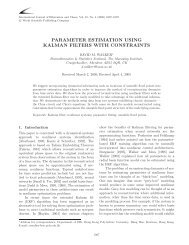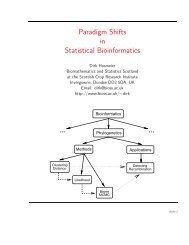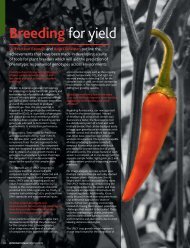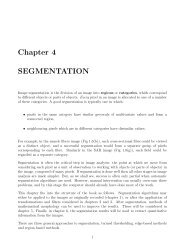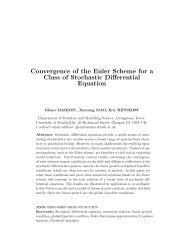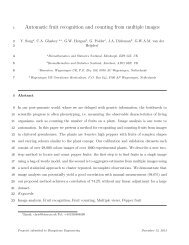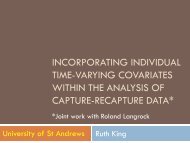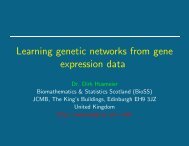CaDDiS A Diagnostic Tool for African Cattle Diseases
CaDDiS A Diagnostic Tool for African Cattle Diseases
CaDDiS A Diagnostic Tool for African Cattle Diseases
- No tags were found...
Create successful ePaper yourself
Turn your PDF publications into a flip-book with our unique Google optimized e-Paper software.
<strong>CaDDiS</strong>A <strong>Diagnostic</strong> <strong>Tool</strong> <strong>for</strong><strong>African</strong> <strong>Cattle</strong> <strong>Diseases</strong>Iain McKendrick(Yiqun Gu, George Gettinby,Craw<strong>for</strong>d Revie)
JustificationIn Sub-Saharan Africa:• Population growth of 3.1% p.a.• Major losses through livestock disease– East Coast Fever alone kills >1,000,000 cattlep.a. in eastern, central and southern Africa– Costing > US$ 165,000,000 p.a.• Shortage of qualified veterinary surgeons
Expert Systems• Rule-Based Systems• Bayesian Belief Networks
Sample Rule from ECFImmunisation ModuleIF animal age < 1 month THEN“ECFiM can only be successfullycarried out in cattle older than 1month. Immunise the calves oncethey reach the age of 1 month,but preferably be<strong>for</strong>e they reachthe age of 4 months.”
Expert Systems• Rule-Based Systems– inflexible– difficulty in incorporating uncertainty• Bayesian Belief Networks– flexible– based on a probabilistic paradigm
A ‘Simple’ Example• In Edinburgh, I overhear a womanspeaking Finnish. What country doesshe probably come from?• What if she was speaking French?• What if we were in Brussels?• What if she then said something inEnglish, with a Scandinavian accent?
Bayes’ TheoremDisease: East Coast FeverOcular Lesions: ‘TRUE’ ‘FALSE’‘TRUE’ 5 6‘FALSE’ 5 970P(ECF)=0.01P(ECF | Ocular Lesions)=0.45P(A | B) = P(B | A) x P(A) / P(B)
Bayesian Belief….• Bayesian updating of probabilitydistributions• Joint distribution of all variables andparameters difficult to handle• Simplify using conditional independence todefine an acyclical directed propagationnetwork
…NetworksChangein urineFeverSwollenlymphnodesAnaplasmosis ECF Babesiosis
Materials• Questionnaire-based data• Derived from veterinary experts• Impossible to collect in<strong>for</strong>mation relatingto conditionals between clinical signs
Anaplasmosis• Intraerythrocytic parasites of ruminants,usually Anaplasma marginale• Spread by 16 species of tick• Resistance in young gives rise to endemicstability
Anaplasmosis Signs• Anaemia• Change in urine• Depression/Lethargy• Transient febrile response• Loss of condition• Drop in milk yield• Inappetance• Laboured breathing• Pale/yellow mucous membranes
Babesiosis (Redwater)• Intraerythrocytic protozoan parasites ofruminants, Babesia bigeminaor Babesia bovis• Largely spread by one host Boophilus spp ticks• Resistance in young gives rise to endemicstability
Babesiosis Signs• Anaemia• Change in urine• Nervous Signs• Fever• Loss of condition• Drop in milk yield• Inappetance• Depression/Lethargy• Jaundice• Accelerated breathing• Muscle tremors
East Coast Fever• Protozoan parasite of ruminants, Theileriaparva• Spread by 3 species of tick, but primarilyRhipicephalus appendiculatus• Resistance in young gives rise to endemicstability
Rhipicephalusappendiculatus
T. parva sporozoites(Michael Shaw,ILRAD)
ECF Signs• Anaemia (??) or Sudden death• Coughing• Swollen lymph nodes• Fever• Inappetance• Loss of condition• Drop in milk yield• Depression/Lethargy• Laboured breathing• Nasal discharge• Diarrhoea• Nervous symptoms
<strong>CaDDiS</strong> in Action• http://vie.dis.strath.ac.uk/vie/<strong>CaDDiS</strong>/
Strengths andWeaknesses: 1• Interesting results• Simple network structure means thatsystem not good at ‘writing off’ redundantin<strong>for</strong>mation
Strengths andWeaknesses: 2• Not based on consensus• Allows <strong>for</strong> variation and uncertainty acrosstime, space and users
Strengths andWeaknesses: 3• Easy to use• Users may misinterpret results– over-interpretation of results– misunderstanding of ‘belief’ statements
Strengths andWeaknesses: 4• Generic• Allows probabilistic inputs• Sometimes difficult to follow the logic...
Conclusions• A successful pilot• Scope to develop useful expert systems• Needs more and better data• A useful teaching tool?• Clinicians don’t need to worry……..
Acknowledgements• Work carried out within VeterinaryIn<strong>for</strong>matics Group, Universities ofGlasgow/Strathclyde• Financed by ODA/DFID• In association with ILRAD/ILRI, Nairobi• Many other experts, but especially TonyIrvin & Susanna Williamson• ILRI/VETAid <strong>for</strong> most of the pictures
Reference• McKendrick, I.J., Gettinby, G., Gu, Y., Reid,S. & Revie, C. (2000) Using a BayesianBelief Network to aid differential diagnosisof tropical bovine diseases. PreventiveVeterinary Medicine, 47, 141-156.





